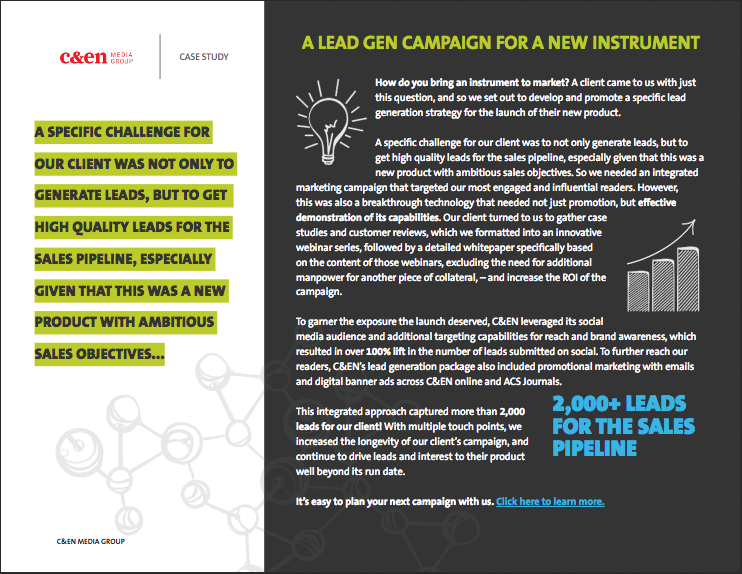When a prospective customer has no experience with your organization, they understandably have questions about your offering. Your sales team is then challenged to demonstrate your organization’s benefits while addressing any relevant concerns.
A case study can help set your prospects’ minds at ease. By showcasing your organization’s approach to unique challenges, and sharing the results you can achieve, you can powerfully persuade prospects and close sales.
One 2016 study of 600 B2B marketers found that lead generation was the most common goal in the industry, with case studies rated as the most effective content for achieving that goal. Another study similarly showed that 71–77 percent of B2B purchasers rate case studies and testimonials as the most persuasive and influential content.
Of course, you need an outstanding case study to realize those benefits. From identifying your story, to working with your clients, to distributing the final product, we outline how to create one.
Identifying the Story You Want to Tell
This first step in creating a compelling case study is choosing its topic. Ask yourself these questions to help find it: What are the challenges you helped clients overcome? How did you solve them? How does the approach you used uniquely represent your company?
As you decide on which story to tell, keep in mind the needs of your ideal prospects. You may have helped solve a unique and difficult challenge, but a case study might not be especially effective if only five percent of your prospects face that same challenge.
Instead, select case studies based on issues that the majority of your prospects struggle with. Highlight your differentiators wherever possible, but ensure that your focus remains adding value.
Remember: case studies are often used as end-of-funnel content, but everyone loves a good success story. If your story is compelling enough, you may be able to effectively pitch it to the media and attract additional attention.
Creating Your Compelling Case Study
With your topic identified, it’s time to craft the actual case study. Begin by prefacing your story: what were the key challenges and what were the goals? Then, how did you solve them? What were your results? What are the next steps?
Many case studies follow a similar, time-tested format, organizing the information into three sections:
– Situation
– Approach
– Results
First, identify the situation you were brought in to help with. Placing the case study within the context of a specific situation, or the broader context of an industry, helps prospects identify with the client in the story. The situation should fully communicate the customer’s goals and how a certain problem prevented them from reaching their goals, then briefly cover the capabilities required as a segue to the approach section.
It’s difficult to effectively communicate your approach and results without first firmly establishing the setting. Novels don’t immediately jump to the climax, and neither should your case study. The most fundamental step of marketing is being understood, and identifying the situation is a key component of understanding.
With your setting established, move on to the approach. How did you tackle this problem? Get specific! The more detail you can provide in a case study, the more compelling it becomes. Speaking in abstractions makes it difficult to communicate the scope of your success; using exact steps and numbers makes your prowess easier to see.
Your solution is also a great place to incorporate differentiators. Why was your organization the best suited to solving this problem? Your approach should answer that question.
Finally, share the results. How effective was the solution in solving the problem? Specificity is again important here. Bigger results are naturally more compelling, but saying that you “increased yield by 1,000 percent” is better than saying you “increased yield several times over.” Numbers are convincing, and you should use them wherever possible.
The results section is also a good place to include the customer’s reaction to the solution. How satisfied were they with the results? What has the impact been on the business?
Communicating with the Client
In the sciences, companies are often wary to provide details for your case studies. Whether there are legal or regulatory concerns, or they don’t wish to reveal any steps of their process, it can be difficult to get your clients on board.
Anonymized case studies are a possibility. Scrubbing a case study of client information is one way to get around regulatory concerns. However, this option usually creates less compelling case studies with fewer specifics, and still requires communication with the client.
Some clients or customers will have established policies for case studies, and you may need to work within their requirements or look elsewhere. Others, especially smaller ones with fewer internal regulations, may be more open to collaboration. Ask around to identify the most willing candidates in your database.

When you have a list of potential case studies, work closely with your clients and customers to determine what details they are comfortable sharing.
Whenever possible, show your client in a positive light. Avoid portraying yourself as the superhero that swoops in to save a disastrous situation; communicate the challenge without doing so at your client’s expense. Presenting your clients positively will make them more willing to cooperate.
As you go through the writing process, stay in communication with the client or customer you feature. Set clear expectations for the details you plan to divulge, the timelines for production, and the means of distribution. Displaying this information openly, and working with them to set schedules, will help in getting and keeping clients on board.
Finally, quote your client or customer whenever possible. Quotes will require approval, but can greatly elevate the persuasiveness of your case studies. It’s one thing to talk glowingly about yourself; it’s much more convincing if someone else talks glowingly about you.
Distributing Case Studies
Distribution of your case studies is as important as production; your story won’t persuade prospects if no one hears it.
Case studies are particularly effective as an end-of-funnel offering, and that allows for several avenues for distribution.
First, sales teams can often make excellent use of case studies. Whether they use a written case study as a leave-behind for prospect meetings or incorporate the story into sales presentations, making sales teams aware of available case studies is crucial.
Case studies can also function well as an online offering. When prospects are interested in your organization but want more information, case studies can help them take the leap and purchase.
How you gate or distribute your case studies depends on why you are promoting them. If you are prospecting and reaching out to an unknown audience, such as social media, try to collect information. But for case studies on your website designed to help visitors choose products, don’t create extra friction by requiring contact information. You want to ensure that prospects make it into your database for follow-up, but you also don’t want to chase away potential customers!
Finally, especially compelling case studies may have broader media appeal. If your solution is unique within your industry, or the results you achieved were particularly astounding, consider pitching the story to reporters at trade publications.
You may be able to use the case study as a jumping off point for your experts, becoming journalists’ go-to source for information on your industry. You may even be able to land a feature or contribute your own article to a publication.
The results from media involvement can be impressive, but be sure to communicate with your client if you choose this route. There is a significant difference between using case studies in sales meetings and distributing them to the public. Your client could be comfortable with one but not the other.
A compelling case study tells a story about your organization. If properly crafted, it can be a powerful tool to showcase your expertise, persuade prospects, and generate sales.


















